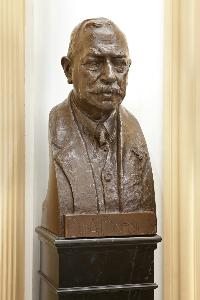Theo Van Reijn
Theo Van Reijn
Place: Breda
Born: 1884
Death: 1954
Biography:
Theo van Reijn, a Dutch sculptor born in Breda, Netherlands in 1884, is renowned for his exceptional skill and artistry. He studied at the Rijksakademie van beeldende kunsten in Amsterdam, where he was taught by notable artists, including Bart van Hove. In 1911, Van Reijn won the Dutch Prix de Rome, which led to a year-long stay in Rome and later work in Paris.
Early Career and Influences
Van Reijn's early career was marked by his exposure to various artistic styles and influences. He attended classes at the Rijksakademie van beeldende kunsten in Amsterdam, where he was introduced to the works of prominent artists. His time in Rome and Paris further broadened his artistic horizons, allowing him to develop a unique style that blended traditional techniques with modern sensibilities.
Notable Works and Exhibitions
Van Reijn's work was showcased in various exhibitions, including the 1939 exhibition and sale Onze Kunst van Heden (Our Art of Today) at the Rijksmuseum in Amsterdam. In 1948, he wrote a book about the foremost Dutch contemporary sculptures, which was published by Elsevier. A notable example of his work can be found in the collection of Breda's Museum, featuring a clock in the style of the Amsterdam School. Other practical objects he created include lamp bases, door knockers, fonts, and bells. Some of his notable works include:
- Bust of Abraham Bredius (1855-1946), a sculpture that can be found at the Mauritshuis in The Hague, Netherlands.
- Portrait Relief of Arnout Vosmaer (1720-1799), a sculpture created by Johann Heinrich Schepp, which is housed at the Mauritshuis in The Hague, Netherlands.
Legacy and Impact
Van Reijn's legacy as a sculptor is evident in his contributions to the Dutch art scene. He was an influential figure, and his work continues to be celebrated by art enthusiasts and scholars alike. For more information about Van Reijn and his works, visit https://Wikioo.org/@@/D3TQC7-Theo-Van-Reijn-Bust-of-Abraham-Bredius-(1855-1946) or https://en.wikipedia.org/wiki/Theo_van_Reijn. Some of the museums that feature his work include:
- Mauritshuis, located in The Hague, Netherlands.
- Rijksmuseum, located in Amsterdam, Netherlands.
Van Reijn's artistic style and contributions to the world of sculpture are a testament to his skill and dedication. His work continues to inspire artists and art enthusiasts, and his legacy will be remembered for generations to come.

